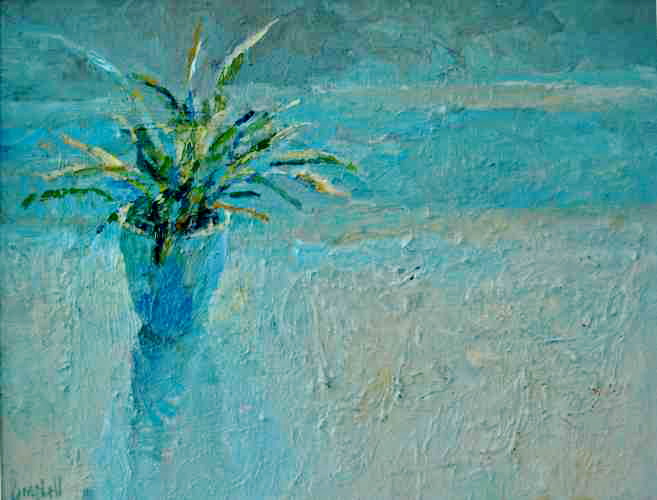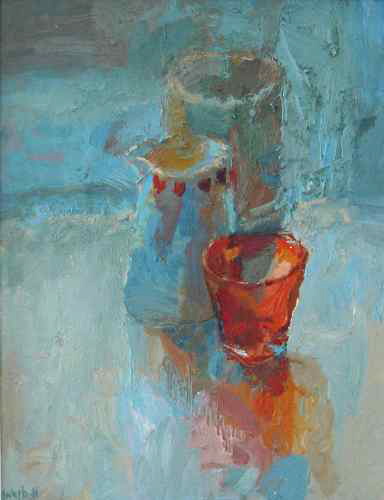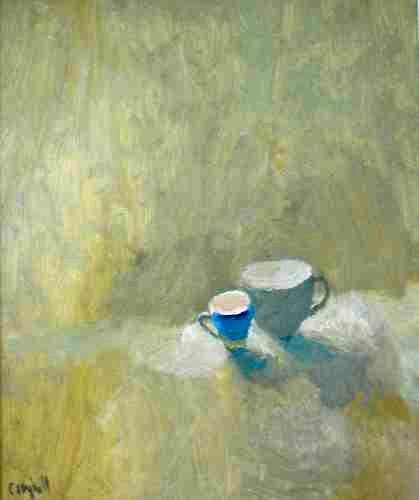
In the week since I first saw Cathy Campbell's solo exhibition at the Union Gallery, I've been struggling to put my finger on what it is about her work which so appeals.
I think in part it is its modesty. Her scenes are quietly understated and domestic. She herself makes no grandiose statements about what she is about, claims no superior understanding or descriptive authority for her paintings of pots, vases, cups and glassware.
In fact, she almost denies herself any kind of voice at all:
'I don't think it's a question of making a portrait of the objects or telling a story,' she writes. 'It's about shapes, colour, darkness and light and their relationship to each other.'
Well, surely she knows best. I believe I see what she means in Ragged Robin (oil on canvas, above-right), and admire it greatly in many other works where there are just such exquisite correlations: fascinating plays of light upon, through, or around various vitreous or ceramic densities and surfaces; tense or resolving questions of mass and order; or – as in Afternoon Spider Plant (oil on board, below) – the brilliant thickening of heat-shimmered air.

I don't for a minute mean to diminish or ignore such achievements, but Campbell's description of her project sounds to me too remote, too cool for what is an exhibition positively suffused with affection and warmth. It seems to me that – despite her claims – she very rarely abstracts emotion from observation. Even from her relationships of shape, colour, darkness and light, one cannot help inferring human parallels.
Campbell encourages this process, I'm certain of it. The objects of her attention are mostly artificial, carefully chosen and artfully arranged. They do not exist in isolation from the artist or the world in which she participates. The titles by which she describes them are peppered with evocative and emotive words: for example, Edinburgh, Gentle, Pair, Soft, Sunny, Welsh. Campbell's creative world is not dispassionate or theoretical at all but profoundly social, and her studies engage rather than depart from complex patterns of personal connection.
In Glass Heart (oil on board, below), three vessels sit almost as if for a Victorian family photograph. The gorgeous red glass binds the two behind it in focused composition, their colours mingle and emerge differently through it as if from one generation to another.

In The Odd Couple (oil on board, below) two differently proportioned cups seem to take comfort from their closeness as they face (or turn their backs upon) some dimly realised gulf at the table's edge.

In Lemonade (below, oil on canvas), the cups and bottle are oddly squashed yet delicate, their departures from the norm accentuating their perfections. They sit upon distinctly coloured, textured surfaces, but there is a suggestion that the cups have more in common with each other than with the bottle, an urgency in how they strain towards each other. There is a suggestion, too, that lemonade has been poured incongruously into china, that some may even have been spilt to judge by the watery blue smear. There is here, then, the subtlest narrative of social unconventionality, of customs or perhaps proprieties breached.

And finally, in 'Silent Group' (oil on board, below), the absence of audible words merely accentuates what is surely a companionable and lively gossip. Perhaps this is Campbell's clearest, wittiest, most delightful exposition of the hitherto secret social life of jugs. AM

Cathy Campbell's Solo Exhibition continues at the Union Gallery (45 Broughton Street) until 2 April.